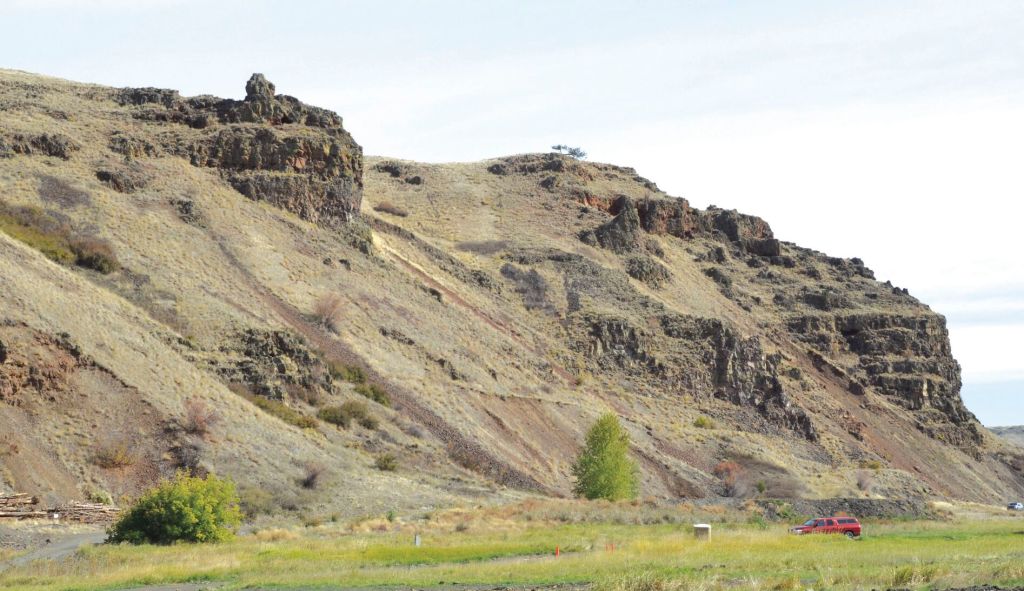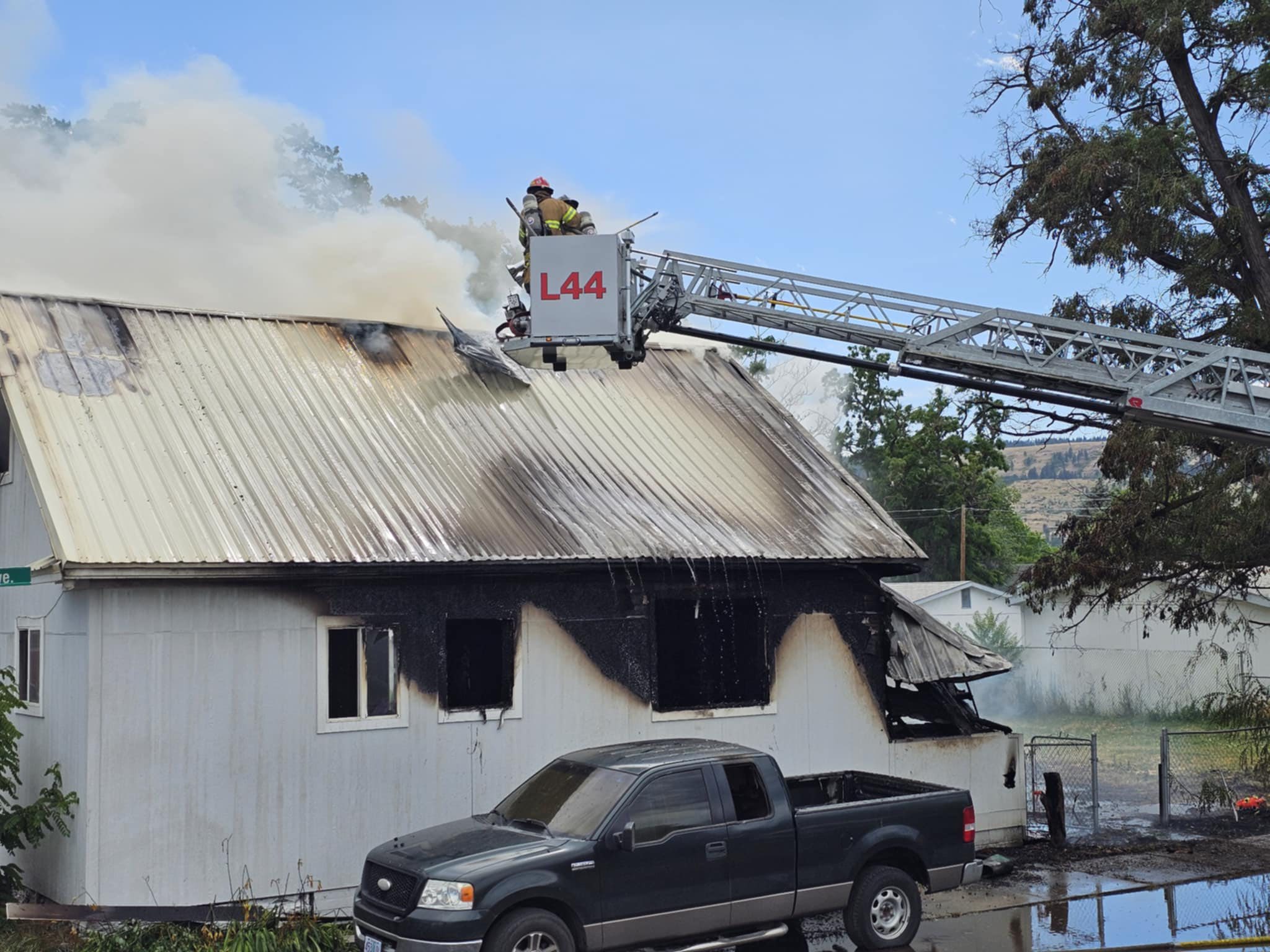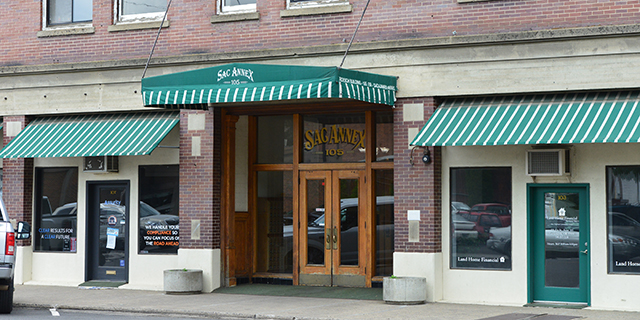Restoration and reconciliation: River channel project blessed
Published 7:00 am Thursday, October 14, 2021

- Majestic Tick Hill overlooks the Nez Perce Wallowa Homeland Project and the town of Wallowa where a blessing ceremony for restoration work on the Wallowa River took place Saturday, Oct. 9, 2021.
WALLOWA — It wasn’t the regular Tamkaliks celebration but, in some ways, it was more. A couple hundred people gathered at the Nez Perce Wallowa Homeland Project the second weekend of October to commemorate and bless a restoration project 10 years in the making and share memories of past celebrations.
For decades, the former wetlands where the Homeland Project is had been turned into farm or pastureland. In the 1950s and the 1970s, bulldozers were brought in to change the landscape so it would not flood, according to Montana Pagano who, with Katie Frenyea, led a tour of the restoration project Saturday, Oct. 9. Pagano and Frenyea have been two of the instrumental workers in developing the project to restore the river to its natural state on behalf of Nez Perce Tribal Fisheries.
The meandering movement of the Wallowa River in its natural state made it difficult — if not impossible — to farm or graze the land between the river and Tick Hill, which overlooks the Homeland Project and where the Tamkaliks dance arbor stands today. The townsite also was susceptible to the seasonal whims of the river.
“They couldn’t have built Wallowa there because the river moved around — I’m talking 150 years ago — so in order to put a townsite there and be confident it wasn’t going to flood, they had to channelize the river,” said Angela Bombaci, executive director of the Homeland Project. “So they tacked it against the hill like this out of the way of the town. … But now we’re trying to undo some of it for the sake of the salmon.”
But, she assured, the restoration work only will affect the north side of the river, not the town side.
“Oh, gosh, no,” she said of any future risk of flood. “We’re actually helping because we’re taking away the flood pressure so it has a place to go over here instead of wanting to go into the town if, for some reason, there ever was a flood risk.”
The channelizing of the river inadvertently destroyed critical fish and plant habitat, which the project aims to restore.
“The point is you want flooding in it,” Bombaci said. “That’s natural and it’s good. All the things that were done were not good for habitat. They were good for farmers and ranchers, but not good for fish or plants that need a wetland, so basically, we returned that area to wetland. Sometimes it will be really wet; sometimes it will be less wet depending on the level of the river. When the river gets higher, more water will come into it. Actually, it’s helpful for the whole area because it’s a release point for floodwater.”
As Bombaci, Pagano and Frenyea explained, there are three side channels that branch off the main river, flood the wetlands and merge to rejoin the river a quarter-mile downstream.
“The three branches of the side channels are in place and all that’s left is the overseeding of the ground that was torn up from construction,” Bombaci said. “Now we sit back and watch nature do her thing for the benefit of lamprey, salmon and other anadromous fish.”
A celebration
Although the weekend’s events were not the traditional Tamkaliks, they were held at the site of the annual celebration and featured many memories of the 30-year-old event.
“This isn’t Tamkaliks. This place is sometimes referred to as Tamkaliks, but the event today is a blessing of our side channel,” Bombaci said. “There will be some drums and some dancing, but it’s not nearly the production Tamkaliks is. It’s basically an opportunity for friends of the projects and friends of the tribal people who have guided this effort to come together and celebrate safely and in a small but important way. We’re just missing each other and we just wanted to find a way to get together. This side channel’s been a dream for 10 years, so it’s a reason to celebrate and we figured we’d squeeze it in on the last sunny day.”
The last actual Tamkaliks celebration was in 2019. The past two — it’s usually held in July — were canceled because of the COVID-19 pandemic.
Tamkaliks originated in either 1990 or 1991 — there was a bit of a friendly disagreement on which year — the brainchild of the late Taz Conner. According to a piece on the Tamkaliks website by former Wallowa High School history teacher Terry Crenshaw, who was close to Conner, he was invited by the city of Wallowa to help plan a tribal festival. A friendship festival with a potluck and a powwow were considered the most appropriate. Numerous locals and tribal members were involved in the effort.
Bombaci said fall weekend’s events were considerably lower key.
About 75 people attended the Friday evening gathering, which included elk/buffalo lasagna. Another 125 or more showed up over the course of Saturday’s day-long events, she said, whereas about 1,000 people usually come to a normal Tamkaliks.
“It was different. It was significantly smaller,” she said. “People weren’t camping. No vendors. No potluck meal. … This was more intimate, doing what we could, given what we could do safely in terms of COVID. But it was beautiful. First time we’ve done anything like this in autumn.”
Everyone asked was thrilled with the lasagna, even though it’s hardly a traditional Nez Perce dish.
“It’s delicious,” said Marty Stevens of Wallowa. “It’s really creamy and gooey and tasteful.”
People came not only from Wallowa County, but from as far away as Portland and El Dorado Hills, California.
“Delicious, delicious. Don’t tell my wife, but it’s better than my wife’s,” joked Jack Johnson of Portland. “We’ve been coming for 20-some years. … It’s a really rewarding thing to come here.”
“It’s delicious,” said Duane Hegglie from California. “We’re just fascinated with the culture and the beauty of the land, the people, everything.”
John Wehr, also from El Dorado Hills, joined Hegglie.
“Duane invited me. I’ve been a student of the culture for a long time. He invited me to come and I’m just excited to be here.”
One attendee, who has generations of local ties to the area, also was pleased with the buffalo/elk lasagna.
“It was really Italian,” said Allen Pinkham Jr. with a laugh. “Nez Perce Italian.”
Memories
Holly Goebel, director of the Wallowa Public Library, joined Bombaci in hosting Saturday’s event. She was able to obtain a $3,000 grant from the American Library Association under the Libraries Transforming Communities umbrella with which she helped fund the cost of the evening and was able to purchase a scanner to help in the work of archiving photographs and other memorabilia of Tamkaliks.
Those archives will be available at https://wallowanezpercearchive.org.
“Because of the project, we were able to, in high quality, scan over 600 images for the Tamkaliks celebration,” Goebel said. “I am really grateful our community embraced the program and we had such a great turnout.”
She said photos and comment cards are starting to come in from the event and she’s eager to get to work on them.
She was quite pleased with the turnout.
“The weather’s not super cooperative, but it’s fall in Wallowa County. It’s beautiful,” she said.
Past, present, future
Tribal elder Allen Pinkham Sr. spoke during the Oct. 9 blessing ceremony.
“This is about reconciliation. It’s about bringing community together and sharing values and trying to develop a better relationship and become one people with the non-Indians,” he said. “We’ve been saying this for a long time. Even Joseph said, ‘We need to be one people.’ What that really means is that as neighbors, we’re not supposed to be taking anything or stealing anything or taking something and calling it your own. Above all, we will not kill one another.”
Pinkham also recognized that the past can’t be forgotten, no matter how unpleasant.
“We need to talk about the past. It’s painful. My father used to say this: ‘We need to talk about what happened in the past that we don’t forget that certain things, though they may be traumatic, and very hurtful and harmful. We need to talk about those things.’ But at the same time, if we become one people, we see those communities come together, no matter who they are or what they represent, that they can be one people and this is a saying of the Nez Perce people going way back. So I think it’s a good thing to see this community and all who are in this community coming together to accomplish something that’s called the Homeland Project.”
But the Lenore, Idaho, man isn’t stuck in the past.
“My father used to say, ‘Don’t forget the past, you talk about the present and then you talk about the future.’ The elders would want to talk about the past and the present and the future. This is the way the conversation would start with the elders. Now, the Homeland Project, I believe, is doing that — talking about the past, the present and the future.”
Bobbie Conner, Taz Conner’s niece, also was there to express her appreciation for how things change.
“I’m grateful to see how things change but I’m also grateful that some things never change,” she said. “Eighty years ago, fisheries biologists were beginning to understand that migratory anadromous fish won’t go home to any stream. They go home to the stream of their birth.”
WALLOWA — Multiple dance contests were a part of festivities at the Nez Perce Wallowa Homeland Project on the afternoon of Saturday, Oct. 9, after the river restoration project had been showcased and blessed.
In the women’s 18 and older open category, the winners were:
• First place: Lynn Pinkham-Meninick, Lenore, Idaho, of the Nez Perce Tribe.
• Second place: Katrina Miller, Mission, of the Yakama Nation.
• Third place: Cece Stanger, Nixyàawii, of the Umatilla Tribe.
In the men’s 18 and older open category, the winners were:
• First place: Aaron Greene, McKay Creek, of the Warm Springs Tribe.
• Second Place: Clifford Stanger, Nixyáawii, of the Umatilla Tribe.
• Third place: Raymond Cree, Pendleton, of the Umatilla Tribe.









